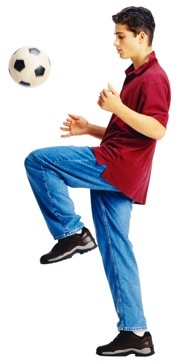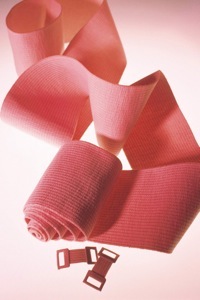-
Common Health Problems


Sprains, Strains & Sports Injuries
“We were playing football on a Saturday afternoon when one guy dislocated a shoulder. You could tell because it was 3 inches lower than the other shoulder. We iced it and took him to the health service.”
– Daniel P., University of the Pacific
Signs, Symptoms & Causes
Sprains
A sprain happens when you overstretch or tear a ligament (fibrous tissue that connects bones). A joint is affected, but there is no dislocation or fracture.
Symptoms are rapid pain, swelling, bruising, and a warm feeling at the injured site.
Sprains usually occur from an accident, injury, or fall.
Strains
A strain is an injury to the muscles or tendons (tissues that connect muscles to bones). Symptoms are pain, tenderness, swelling, and bruising. A strain occurs when you overstretch or overexert a muscle or tendon (not a ligament). This is usually caused by overuse and injuries, such as sports injuries.
Self-Care
To Prevent Serious Injuries (especially during contact sports)
-
•Wear the right protective gear and clothing for the sport. Items to wear include a helmet, shoulder, knee, and wrist pads, a mouth guard, etc.
-
•Train in the sport so you learn how to avoid injury. “Weekend athletes” are prone to injury.
-
•Follow the rules that apply to the sport.
General Prevention
-
•Ease into any exercise program. Increase activity gradually.
-
•Do warm-up stretching exercises before the activity. Stretch and hold for at least 30 seconds. Don’t bounce.
-
•Wear proper-fitting shoes that provide shock absorption and stability.
-
•Avoid running on hard surfaces like asphalt and concrete. Run on flat surfaces instead of uphill. Running uphill aggravates the stress put on the Achilles tendon.
-
•Use the softest surface available when you exercise.
-
•Wear shoes and socks that fit well. The widest area of your foot should match the widest area of the shoe. You should also be able to wiggle your toes with the shoe on, in both a sitting and standing position. The inner seams of the shoe should not rub against areas of your feet.
-
•Avoid locking your knees. When jumping, land with your knees bent.
-
•Don’t overdo it. Stop if you feel pain.
-
•Cool down after exercise. Do the activity at a slower pace for 5 minutes.

Sports Injuries
-
•Achilles tendon pain is caused by a stretch or tear or irritation to the tendon that connects the calf muscles to the back of the heel.
-
•Blisters are due to friction, such as from poor fitting shoes or socks.
-
•Muscle soreness occurs when you have worked out too hard and too long.
-
•Shinsplints are mild to severe aches in front of the lower leg.
-
•Stress fractures are microfractures which usually involve the bones of the feet or legs. They are usually caused by a sudden increase in the amount of weight bearing exercise being done.
Sports injury symptoms vary depending on the injury. They include pain, tenderness, swelling, and bruising. Bones may be broken or dislocated.
Treatment
Treatment depends on the injury and the extent of damage. Self-care may suffice for mild injuries.
Sports injuries and sprains may need medical treatment. Some sprains require a cast. Others may need surgery if the tissue affected is torn.
Broken bones (other than broken toes) need immediate medical care.

Do you suspect a head, neck, or spinal injury by any of these symptoms?
-
•Inability to move the head, neck, or back.
-
•Inability to open and close the fingers or move the toes or any part of the arms or legs.
-
•Feelings of numbness in the legs, arms, shoulders, or any other part of the body.
-
•It looks like the head, neck, or back is in an odd position.
-
•Immediate neck pain.
{Note: If any of the above problems exist, tell the person to lie still and not move his or her head, neck, back, etc. Place rolled towels, articles of clothing, etc. on both sides of the neck and/or body. Tie and wrap them in place, but don’t interfere with the person’s breathing. If necessary, use both of your hands, one on each side of the person’s head, to keep the head from moving. Call 9-1-1!}


Questions to Ask



Did a strain or sprain occur with great force from a vehicle accident or a fall from a high place?



Are any of these signs present?
-
•A bone sticks out or bones in the injured part make a grating sound.
-
•An injured body part looks bent, shortened, or misshaped.
-
•You can’t move the injured body part or put weight on it.
-
•The injured area is blue, pale or feels cool, but the same limb on the other side of the body does not.

Are any of these signs present?
-
•You can’t bend or straighten an injured limb.
-
•Bad pain and swelling occur or the pain gets worse.
-
•Pain is felt when you press along the bone near the injury.



Does the sprain or strain not improve after using self-care measures for 2 days?


{Note: If you are in a sports program and have an injury, contact your trainer.}

To Treat a Sprain, Strain, or Sports Injury
-
•If the injury does not appear serious, stop what you are doing and use R.I.C.E.:
-
-Rest the injured area for 24 to 48 hours.
-
-Ice the injured area as soon as possible and keep doing so for 10 minutes every 2 hours for the next 48 hours. Use an ice pack, ice in a heavy plastic bag with a little water, a bag of frozen vegetables, etc.
-
-Compress the area. Wrap with an elastic bandage. Numbness, tingling, or increased pain means the bandage is too tight. Remove the bandage every 3 to 4 hours and leave it off for 15 to 20 minutes each time.
-
-Elevate the injured area above heart level, if possible.
-
•Take an over-the-counter medicine for pain, if necessary. (See “Pain Relievers” in “Over-the-Counter Medication Safety.”)
{Note: Many sports medicine providers do not recommend aspirin-like medication at first because it can aggravate bleeding and bruising.}
Use an elastic bandage to compress the injured area.
-
•If you sprained a finger or hand, remove rings. (If you don’t and your fingers swell up, the rings may have to be cut off.)
-
•Try liniments and balms. These provide a cooling or warming sensation. These ointments only mask the pain of sore muscles, though. They do not promote healing.
-
•Once the injured area begins to heal, do M.S.A. techniques:
-
-Movement. Work to establish a full range of motion as soon as possible after an injury. This will help maintain flexibility during healing and prevent scar tissue formed by the injury from limiting future performance.
-
-Strength. Gradually strengthen the injured area once the inflammation is controlled and a range of motion is back.
-
-Alternative Activities. Do regular exercise using activities that do not strain the injured part. Start this a few days after the injury, even though the injured part is still healing.

Copyright © 2007, American Institute for Preventive Medicine. All rights reserved.



For more information, contact:
MedlinePlus® Health Information | www.medlineplus.gov | Search for “First Aid / Emergencies.”

